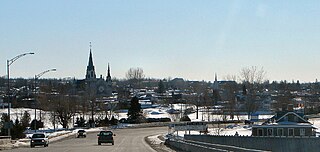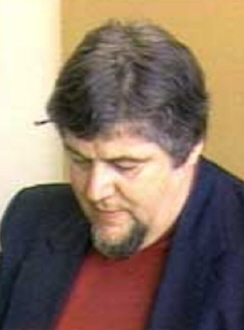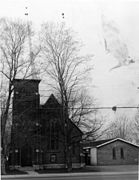
The Ottawa River is a river in the Canadian provinces of Ontario and Quebec. It is named after the Algonquin word 'to trade', as it was the major trade route of Eastern Canada at the time. For most of its length, it defines the border between these two provinces. It is a major tributary of the St. Lawrence River and the longest river in Quebec.

Brockville, formerly Elizabethtown, is a city in Eastern Ontario, Canada, in the Thousand Islands region. Although it is the seat of the United Counties of Leeds and Grenville, it is politically independent of the county. It is included with Leeds and Grenville for census purposes only.

Franco-Ontarians are Francophone Canadians that reside in the province of Ontario. Most are French Canadians from Ontario. In 2021, according to the Government of Ontario, there were 650,000 Francophones in the province. The majority of Franco-Ontarians in the province reside in Eastern Ontario, Northeastern Ontario, and Central Ontario, although small francophone communities may be found in other regions of the province.

Athens is a township in the United Counties of Leeds and Grenville in Eastern Ontario, Canada. It is located approximately 25 kilometres (16 mi) north of the St. Lawrence River, near Brockville, west of Addison, and about 90 kilometres (56 mi) south west of Ottawa. Formerly, it was a part of Yonge township before becoming Rear of Yonge and Escott with Athens as its own census division and finally, Athens township. The township consists of the town of Athens and a few other small communities.

North Grenville is a township in eastern Ontario, Canada, in the United Counties of Leeds and Grenville on the Rideau River. It is located just south of Ottawa in Canada's National Capital Region.

Hawkesbury is a town in the United Counties of Prescott and Russell in Eastern Ontario, Canada. Hawkesbury is the third most bilingual town in Ontario, with about 70% of its inhabitants being fluent in English and French. Franco-Ontarians make up 89% of the population.

Eastern Ontario is a secondary region of Southern Ontario in the Canadian province of Ontario. It occupies a wedge-shaped area bounded by the Ottawa River and Quebec to the northeast and east, the St. Lawrence River and New York to the south, and Northern Ontario and Central Ontario to the west and northwest.

Kemptville is a community located in the Municipality of North Grenville in Eastern Ontario, Canada in the northernmost part of the United Counties of Leeds and Grenville. It is located approximately 56 km (35 mi) south of the downtown core of Ottawa and 2.5 to 3 km south of the Rideau River.

Grenville-sur-la-Rouge is a municipality in the Argenteuil Regional County Municipality in the Laurentides region of Quebec, Canada. It is a predominantly Francophone community situated along the southern border of Quebec between Montreal and Ottawa.

South Algonquin is a township municipality in Nipissing District, Ontario, Canada. Located south of Algonquin Provincial Park, it is the sole populated portion of the district that lies south of the traditional dividing line between Northern Ontario and Southern Ontario and is closer connected to Renfrew County as opposed to the core portions of Nipissing District.
Association of Colleges and Universities of the Canadian Francophonie is an association of community colleges and universities in minority francophone communities in Canada, through cooperation between its member institutions. The association represents its member institutions on topics of mutual interest before the Government of Canada, national and international organizations.

Grenville is a village municipality in the Argenteuil Regional County Municipality of the Laurentides region of Quebec, Canada. It is located opposite Hawkesbury, Ontario, on the Ottawa River.

Pointe-Calumet is a municipality in the Canadian province of Quebec. The municipality is located within the Deux-Montagnes Regional County Municipality in the Laurentides region. It is situated about 30 minutes northwest of Montreal. Its population as of the 2021 Canadian Census is just over 6 000.

Saint-André-d'Argenteuil is a municipality in the Laurentides region of Quebec, Canada, part of the Argenteuil Regional County Municipality. It is located along the Ottawa River, just south of Lachute.

The Long-Sault Bridge is a bridge connecting Hawkesbury, Ontario and Grenville, Quebec. It crosses the Ottawa River via Chenail Island. It connects Quebec Route 344 and Ontario Highway 34, and is the only fixed crossing of the Ottawa River between Ottawa and Montreal.

The Ottawa River timber trade, also known as the Ottawa Valley timber trade or Ottawa River lumber trade, was the nineteenth century production of wood products by Canada on areas of the Ottawa River and the regions of the Ottawa Valley and western Quebec, destined for British and American markets. It was the major industry of the historical colonies of Upper Canada and Lower Canada and it created an entrepreneur known as a lumber baron. The trade in squared timber and later sawed lumber led to population growth and prosperity to communities in the Ottawa Valley, especially the city of Bytown. The product was chiefly red and white pine.The Ottawa River being conveniently located with access via the St. Lawrence River, was a valuable region due to its great pine forests surpassing any others nearby. The industry lasted until around 1900 as both markets and supplies decreased, it was then reoriented to the production of wood pulp which continued until the late 1990s and early 2000s.

The Perley Bridge was a bridge connecting Hawkesbury, Ontario and Grenville, Quebec. It crossed the Ottawa River via Chenail Island. It was named for George Perley, Canadian Member of Parliament representing the Argenteuil district in southern Quebec. He first advocated for a crossing at Hawkesbury in 1909. The bridge was known as the Hawkesbury–Grenville Bridge, or less frequently the Grenville–Hawkesbury Bridge prior to its completion in 1931 when the name Perley was applied. It was replaced by the Long-Sault Bridge in 1998.
The Carillon and Grenville Railway (CAGR) was a 5 ft 6 in broad gauge portage railway in Quebec, running approximately 12 miles (19 km) between the towns of Carillon and Grenville on the north bank of the Ottawa River. It provided a through-route from Ottawa to Montreal via steamships on either side of the Long Sault Rapids. It was one of Canada's earliest railways, opened in 1854, and was the last operational broad gauge railway in Canada when it closed in 1910.

Marcel Desjardins was a Canadian journalist, news editor and director. He was a political correspondent for Le Droit and La Presse, before becoming an editor at Radio-Canada. He later returned to La Presse as the news director, then as the vice-president and assistant editor. He also covered ice hockey and was recognized with the Elmer Ferguson Memorial Award by the Professional Hockey Writers' Association.























